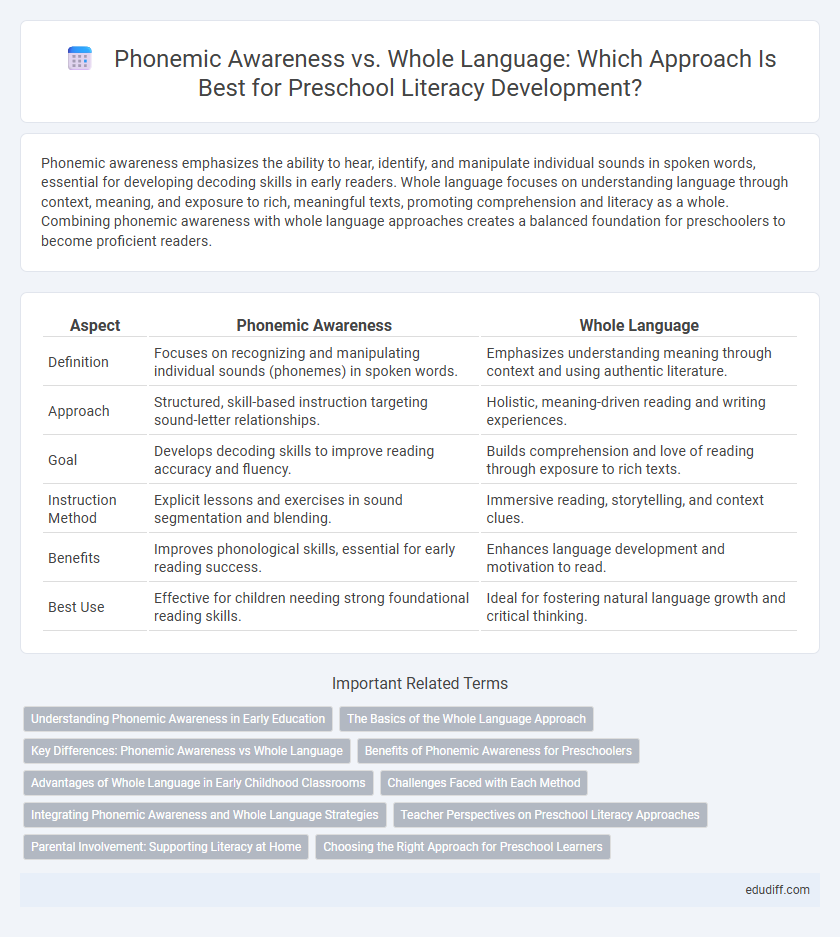Phonemic awareness emphasizes the ability to hear, identify, and manipulate individual sounds in spoken words, essential for developing decoding skills in early readers. Whole language focuses on understanding language through context, meaning, and exposure to rich, meaningful texts, promoting comprehension and literacy as a whole. Combining phonemic awareness with whole language approaches creates a balanced foundation for preschoolers to become proficient readers.
Table of Comparison
| Aspect | Phonemic Awareness | Whole Language |
|---|---|---|
| Definition | Focuses on recognizing and manipulating individual sounds (phonemes) in spoken words. | Emphasizes understanding meaning through context and using authentic literature. |
| Approach | Structured, skill-based instruction targeting sound-letter relationships. | Holistic, meaning-driven reading and writing experiences. |
| Goal | Develops decoding skills to improve reading accuracy and fluency. | Builds comprehension and love of reading through exposure to rich texts. |
| Instruction Method | Explicit lessons and exercises in sound segmentation and blending. | Immersive reading, storytelling, and context clues. |
| Benefits | Improves phonological skills, essential for early reading success. | Enhances language development and motivation to read. |
| Best Use | Effective for children needing strong foundational reading skills. | Ideal for fostering natural language growth and critical thinking. |
Understanding Phonemic Awareness in Early Education
Phonemic awareness in early education involves recognizing and manipulating individual sounds in spoken words, which is essential for developing reading skills and decoding abilities. Unlike the whole language approach that emphasizes understanding meaning through context and exposure to complete texts, phonemic awareness focuses on the auditory component of language, helping children connect sounds to letters systematically. Research shows that strong phonemic awareness in preschoolers significantly improves their ability to acquire literacy, making it a critical foundation for successful reading development.
The Basics of the Whole Language Approach
The Whole Language approach in preschool emphasizes understanding language as a complete system, promoting reading through context, meaning, and authentic literature rather than isolated phonetic drills. This method encourages children to engage with stories, recognize words in meaningful contexts, and develop a love for reading by integrating listening, speaking, reading, and writing activities. It contrasts with phonemic awareness, which focuses on the sounds of language as the foundation for decoding words, by prioritizing holistic language experiences over segmented skill instruction.
Key Differences: Phonemic Awareness vs Whole Language
Phonemic awareness emphasizes the ability to hear, identify, and manipulate individual sounds in spoken words, serving as a foundational skill for decoding and early reading success. In contrast, the whole language approach integrates reading and writing by focusing on meaning and context, encouraging children to recognize words as whole pieces rather than breaking them down into smaller sounds. These key differences impact instructional strategies, with phonemic awareness targeting auditory processing skills and whole language promoting comprehension through exposure to rich, meaningful text.
Benefits of Phonemic Awareness for Preschoolers
Phonemic awareness enhances preschoolers' ability to recognize and manipulate individual sounds, laying a critical foundation for reading and spelling skills. This skill supports early literacy development by improving decoding abilities and phonological processing, essential for successful word recognition. Research shows children with strong phonemic awareness are more likely to achieve reading fluency and comprehension as they progress in school.
Advantages of Whole Language in Early Childhood Classrooms
Whole Language promotes natural language learning through immersive reading and writing experiences, fostering children's comprehension and critical thinking skills. Emphasizing context and meaning, it encourages children to develop a love for reading by connecting texts to their personal experiences. This approach supports vocabulary growth and fluency, crucial for early literacy development in preschool classrooms.
Challenges Faced with Each Method
Phonemic awareness instruction often faces challenges such as difficulty engaging young learners who struggle with abstract sound manipulation and limited contextual learning, leading to potential gaps in comprehension and retention. Whole language approaches can encounter obstacles due to insufficient emphasis on phonics, causing children to miss foundational decoding skills and struggle with unfamiliar words. Balancing explicit phonemic instruction with meaningful, context-rich reading experiences is essential to overcoming the limitations inherent in each method during early literacy development.
Integrating Phonemic Awareness and Whole Language Strategies
Integrating phonemic awareness with whole language strategies enhances preschool literacy by combining the systematic recognition of sound patterns with meaningful text experiences, promoting fluent reading and comprehension. Explicit phonemic exercises, such as segmenting and blending sounds, complement the contextual understanding gained from storytelling and environmental print. This balanced approach supports diverse learning styles and fosters early reading skills essential for long-term academic success.
Teacher Perspectives on Preschool Literacy Approaches
Teacher perspectives on preschool literacy approaches emphasize the critical distinction between phonemic awareness and whole language methods. Educators recognize phonemic awareness as foundational for decoding skills, enhancing children's ability to identify and manipulate individual sounds in words. Whole language approaches are valued for fostering holistic language immersion and comprehension, promoting meaningful reading experiences through context and literature-rich environments.
Parental Involvement: Supporting Literacy at Home
Parental involvement plays a crucial role in supporting phonemic awareness and whole language learning at home by engaging children in activities such as letter-sound games and storytelling. Encouraging daily reading routines and interactive conversations helps strengthen children's ability to recognize sounds and understand language context. Consistent reinforcement through playful literacy practices fosters early reading skills and boosts confidence in preschool learners.
Choosing the Right Approach for Preschool Learners
Phonemic awareness, emphasizing the recognition and manipulation of individual sounds, develops critical early literacy skills in preschool learners, especially in decoding words. Whole language approaches promote comprehension and meaning through immersion in rich, contextual language experiences, supporting vocabulary growth and language enjoyment. Selecting the right approach depends on balancing phonics instruction with meaningful reading activities to match developmental readiness and foster a lifelong love of reading.
Phonemic Awareness vs Whole Language Infographic

 edudiff.com
edudiff.com